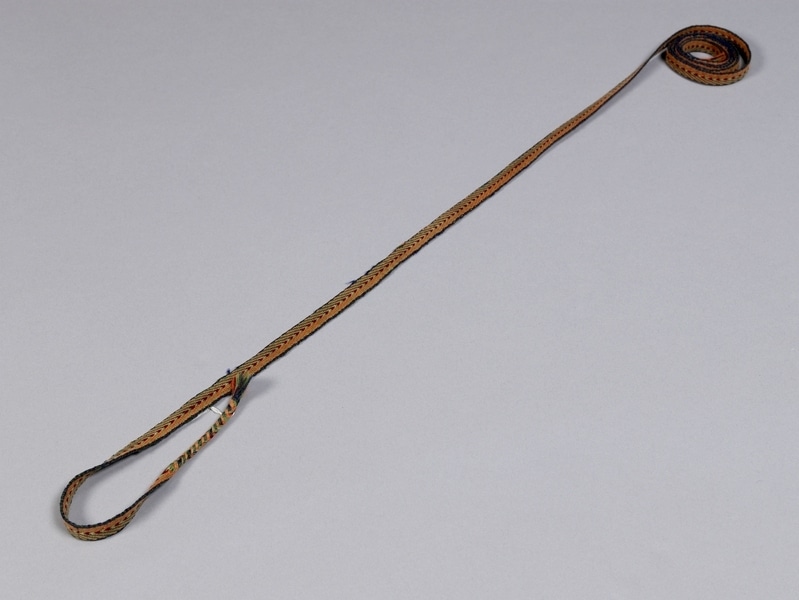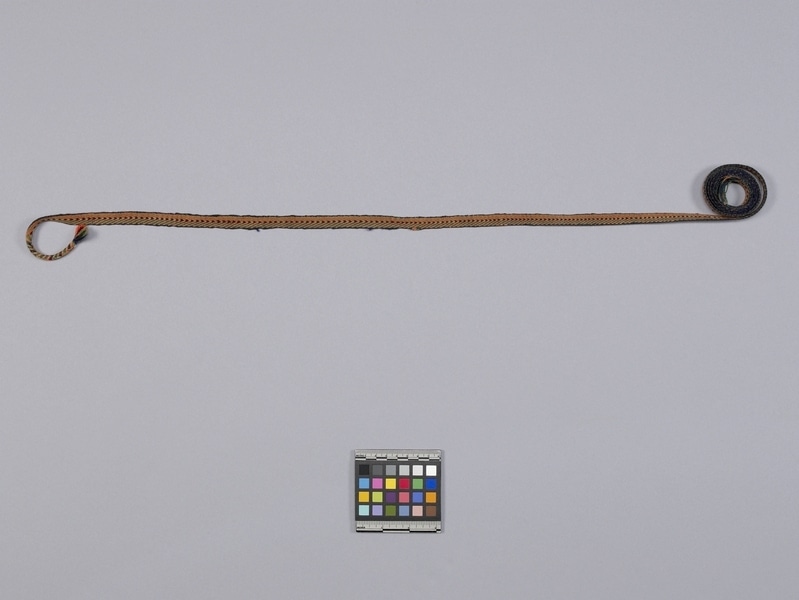Belt Item Number: Sf993 from the MOA: University of British Columbia


Description
Belt composed of a narrow, warp-faced band with a herringbone pattern running the length of it. Shades of orange and green predominate with a fleck of red-purple in the centre and dark blue-green edges. One end of the band finishes in unworked warps with cut ends and the other end is finished with a square braid.
History Of Use
Warp-faced fabrics with three or four selvedges are woven by women on the indigenous style loom, a staked-out horizontal ground loom, or an adjustable tension (body) loom. The technique and structure have pre-Conquest antecedents, and as in ancient times, the fabrics are used in their rectangular form without cutting or shaping. Narrow bands have a number of miscellaneous uses as ties and straps. They are also used to swaddle babies, of both sexes, to the age of 3 months. They hold the swaddling cloth in place by criss-crossing 2 or 3 times as the ends of the band wrap around the baby's body.
Cultural Context
swaddling
Narrative
Made by Eufrasia Yucra Huatta, a young married woman, a year or so before it was collected. It was used for holding the swaddling cloths of a young baby in place.
Specific Techniques
The yarns are z spun and 2 ply s. The yarns appear to be commercially spun and are probably synthetic fibre; structure is a complementary-warp weave with 2 span floats. Unworked warps made into 8 strand square braid of 2/2 interlacing and finished off by wrapping with a separate element. Loom-shaped.
Item History
- Made by Eufrasia Yucra Huatta (Maker) in Taquile, Puno, Peru before 1983
- Collected by Elizabeth L. Johnson during 1984
- Owned by Elizabeth L. Johnson before June 13, 1984
- Received from Elizabeth L. Johnson (Seller) and Museum of Anthropology Shop Volunteers (Funding source) on June 13, 1984
What
- Name
- Belt
- Identification Number
- Sf993
- Type of Item
- belt
- Material
- wool fibre ?, synthetic fibre ? and dye
- Manufacturing Technique
- woven and retwisted
- Overall
- height 1.2 cm, width 153.0 cm
Who
- Culture
- Quechua
- Creator
- Eufrasia Yucra Huatta (Maker)
- Field Collector
- Elizabeth L. Johnson
- Previous Owner
- Elizabeth L. Johnson
- Received from
- Elizabeth L. Johnson (Seller) and Museum of Anthropology Shop Volunteers (Funding source)
Where
- Holding Institution
- MOA: University of British Columbia
- Made in
- Taquile, Puno, Peru
When
- Creation Date
- before 1983
- Collection Date
- during 1984
- Ownership Date
- before June 13, 1984
- Acquisition Date
- on June 13, 1984
Other
- Item Classes
- textiles
- Condition
- fair
- Accession Number
- 0992/0016